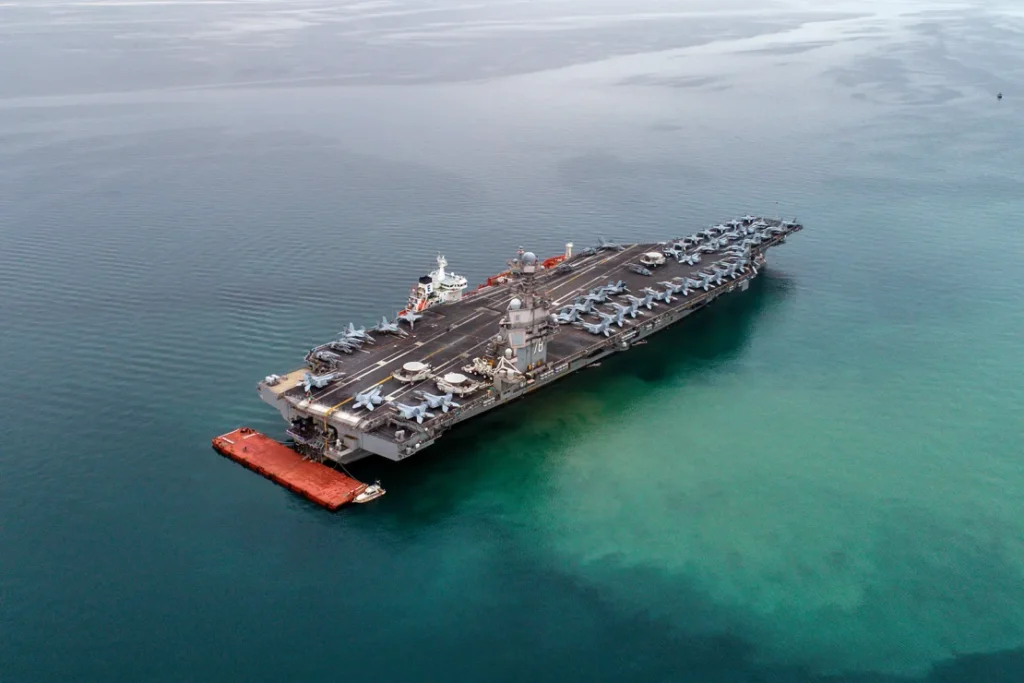
Introduction Of China’s
As the maritime world watches with anticipation, China’s latest addition to its naval fleet, the Fujian aircraft carrier, commenced its inaugural sea trials from Shanghai, marking a significant stride in the country’s naval capabilities. This endeavor underscores China’s ambition to assert its presence in global maritime affairs and underscores its technological advancements in naval engineering. The maiden voyage of the Fujian, touted as the world’s largest and most advanced aircraft carrier, holds implications not only for regional dynamics but also for the broader global balance of power.

Table of Contents
A Technological Marvel: The Fujian’s Unique Features
At the heart of the Fujian’s prowess lies its cutting-edge electromagnetic catapult system, distinguishing it from its predecessors and putting it on par with the United States’ USS Gerald R Ford. This technological innovation allows for the launch of larger and heavier aircraft, significantly enhancing the carrier’s combat capabilities. With a displacement of 80,000 metric tons, the Fujian eclipses its predecessors, the Shandong and Liaoning, enabling it to carry a greater payload and extend its operational range.
Analysts predict that the Fujian’s ability to deploy larger warplanes carrying heavier munitions over longer distances will grant the People’s Liberation Army Navy (PLAN) formidable “blue-water” capabilities, marking a significant evolution in China’s maritime strategy. Moreover, its propulsion and electrical systems, subjected to rigorous testing during the sea trials, will determine its reliability and stability in challenging maritime environments.
Implications for Naval Power Dynamics
The emergence of the Fujian represents a pivotal moment for China’s naval ambitions, catapulting it into the elite league of carrier aviation-capable navies. This development, coupled with China’s expanding fleet, underscores the country’s emergence as a dominant maritime power. As the Fujian joins the PLAN fleet, it symbolizes the culmination of China’s efforts to bolster its naval capabilities, boasting a fleet of over 340 warships.
However, while the Fujian’s technological prowess is commendable, it is essential to acknowledge the enduring advantages of the United States’ naval fleet. The US carriers, powered by nuclear propulsion, enjoy extended operational endurance, unmatched by conventional fuel-powered vessels like the Fujian. Additionally, the sheer size of US carriers affords them greater capacity, enabling them to accommodate a larger complement of aircraft.
Looking Ahead: Future Prospects and Strategic Implications
As the Fujian embarks on its sea trials, observers speculate on its commissioning timeline, with estimates ranging from next year to 2026. This period will witness further testing and refinement, ensuring the carrier’s readiness for operational deployment. Meanwhile, discussions surrounding the prospect of a fourth carrier for the Chinese fleet, potentially nuclear-powered, hint at China’s enduring commitment to naval expansion.
In parallel, the United States continues its carrier modernization efforts, with three Ford-class carriers under construction, underscoring the enduring competition in naval power dynamics. The strategic implications of these developments reverberate across regional and global spheres, shaping geopolitical calculations and maritime security paradigms.

Conclusion
The maiden sea trials of the Fujian aircraft carrier herald a new chapter in China’s naval history, signifying its ascent as a formidable maritime power. As the Fujian undergoes rigorous testing and evaluation, it underscores China’s technological prowess and strategic ambitions in the maritime domain. While challenges persist, the emergence of the Fujian portends a recalibration of naval power dynamics, with far-reaching implications for regional stability and global security.






One Comment